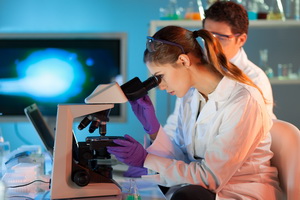
"Your biopsy is sent for histological analysis," - a phrase familiar to many of us. What is behind it?
A biopsy is a tiny particle of tissue taken by a doctor from a "suspect" place, for example, a tumor, a polyp, which does not heal the sores for a long time. Depending on where it is taken, use different tools. It can be a thick needle, an endoscope (when you are examining the esophagus or stomach), a light guide (with bronchoscopy), a conventional scalpel (during a surgical operation).
The main purpose of the biopsy is diagnosis. It allows you to establish whether a benign or malignant process is to be fought. This procedure is also used when monitoring the treatment of cancerous tumors. It is right to take a biopsy - a special art that requires experience and skill from the doctor. From the accuracy of his choice (and at the beginning of his existence, the malignant focus is very tiny) depends on the result of the analysis and, accordingly, the choice of tactics of treatment.
The pieces of tissue obtained by biopsy are sent to a special laboratory where histological analysis is performed. It is based on the fact that all cells in the body have a characteristic structure, depending on what kind of tissue they belong to. With malignant degeneration, the picture changes radically: the inner structure of the cell is broken, it ceases to be similar to the neighboring ones. These violations, as a rule, are so significant that they can be seen in an ordinary microscope.
But before considering the material taken during the biopsy, it must be processed in a special way: cut into very thin transparent slices (called slices) and stain. To prepare slices, a piece of cloth is first made hard (impregnated, for example, with paraffin), and then, having fixed in a special holder, cut using a special super-sharp knife - microtome.
The resulting thin film is placed on small oblong glass and directly exposed to color. There are a lot of ways of coloring, but they have one thing in common - they are all conducted in several stages. Previously, drugs were transferred from the bath to the bath by hand, now all the stages of coloring are capable of carrying out special devices. But this is perhaps the only stage where automation is possible. All the others entirely depend on the skill and attention of specialists.
When the colored preparation is under the eyepiece of the microscope, the pathologist enters into the case - the doctor is extremely important in the medicine of specialization. Having evaluated the characteristics of the cells under investigation, he makes his verdict: a benign or malignant tissue was biopsy. Moreover, depending on the type of cancer "breakages" of cells, it is often possible to determine also the type, features and even the prognosis of the disease.
When study under a light microscope is not enough, resort to immunohistochemical research. In this case, the sections are treated with several (in each case different) antitumor sera. If the "directivity" of one of them coincides with the nature of the tumor, yellowish granules appear in the cells of the preparation, clearly visible under the microscope. So, this method has proved well in the diagnosis of melanoma - easily giving metastases of malignant skin tumors.
In some cases, when it is necessary to understand what changes have taken place in the "internal organs" of cells, electronic microscopy comes to the rescue. The huge increase (up to 100 thousand times) that the electron microscope gives has its merits and demerits: allowing even large molecules to be considered, it is at the same time capable of keeping only a few cells in view. This makes thousands of times more important how accurately the material was taken for the study (both during the biopsy, and during the manufacturing and selection of sections).


